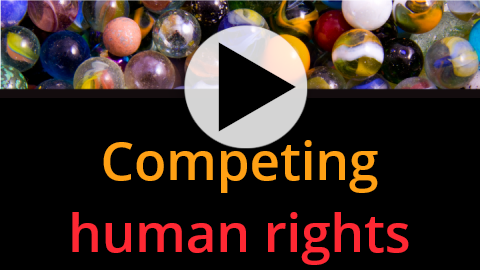Competing Human Rights
Learn about Competing Human Rights under the Ontario Human Rights Code.
This 5-part (45 minute) eLearning series is for public, private and not-for-profit sectors. Learn more about competing human rights using interactive videos, short documents and scenarios.

Part 1 - Introduction
Welcome to the Ontario Human Rights Commission’s Competing Human Rights eLearning training.
Transcript Competing Human Rights eLearning Module 1
NARRATOR:
Hello and welcome …to the Ontario Human Rights Commission’s Competing Human Rights eLearning training.
More people are learning about their rights and standing up for them, and sometimes their rights conflict with the rights of others.
Competing rights issues are in the news, and organizations are planning for and dealing with competing rights issues in the workplace, in schools, in housing accommodation and in services. That’s why the Ontario Human Rights Commission (or OHRC) developed the Policy on Competing Human Rights.
By the end of this training, you’ll understand how to apply the key parts of this policy. Using interactive videos, short documents, and scenarios, you’ll learn about what competing rights are, and what types of situations are actually not competing rights. We’ll use a realistic scenario to go through the OHRC’s framework for analyzing and addressing competing human rights situations step-by-step. This is especially useful if you are looking for information on resolving competing rights issues, or want to develop competing rights policies and procedures. You’ll also learn the key legal principles that are essential for analyzing most competing rights situations.
Taking the full training will give you a good understanding of the OHRC’s Policy on Competing Human Rights. But this training is flexible - you don’t have to take the whole thing at once. If you’d like to focus on any part of the Policy, you can find the modules that will help and only take those portions of the training. Or, you may just want to see some examples of competing rights situations that are relevant to your work. And, since many of you will be sharing the information that you learn in this training with your colleagues and others, we’ve made all of our materials available for download.
We hope that this training provides the information you need about competing human rights. When you’re finished, please take the short survey. Your feedback will help us improve our eLearning resources. Thank you, and enjoy learning about competing human rights!
Competing Human Rights eLearning Transcript at http://ohrc.on.ca/en/learning/competing-human-rights/welcome-and-introdu...
Simplified flow chart for competing rights conciliation
Flow chart for competing rights conciliation
This is a simplified version of the “Flow chart for competing rights conciliation” found in the Policy. It will give you a general idea about the overall stages involved in reconciling competing rights situations. You might want to print it off and keep it handy as you go through the course, so that you can see how the information you’re learning fits into the process.
Not a competing rights claim. |
 |
Stage 1:Is this a legitimate competing rights claim? |
|||||||
 |
 |
||||||||
Regular human rights approaches. |
Competing rights claim. |
||||||||
 |
|||||||||
 |
Select an Alternative Dispute Resolution Model |
 |
|||||||
Quick resolution |
Full Process |
||||||||
 |
Stage 2:Reconciling Competing Rights |
 |
|||||||
 |
|||||||||
Stage 3:Making Decisions |
Part 2 - Reducing the Potential for Conflict
Transcript Competing Human Rights eLearning Module 2 NARRATOR: Welcome to Module 2. You’ll learn how to tell the difference between human rights and other types of rights, interests and values. You’ll use this information when analyzing a competing rights situation. Human rights are for everyone. In Canada, they are protected and interpreted through: • the Canadian Charter of Rights and Freedoms • provincial, territorial and federal human rights laws • decisions of tribunals and courts • human rights commissions • and international law. For example, the Ontario Human Rights Code is a provincial law that gives everybody equal rights and opportunities without discrimination in jobs, housing, services and other areas. The Code’s goal is to prevent discrimination and harassment because of race, sexual orientation, disability, creed, and other Code grounds. Human rights are given a special, highly protected status by the law. We’ll talk more about the Code in the next section. Legal entitlements can be described as rights that are also protected by law, but do not have the same special status as human rights. For example, in Ontario, the Residential Tenancies Act protects a person’s right to “reasonable enjoyment” of their rental housing. An interest is a matter in which someone has a personal concern, share, portion or stake. Interests are generally not legal rights, but in some cases an interest could be raised to the status of a right, like in “the best interests of the child”. Values are moral principles, standards or things that a person (or group) believes are vital for being a good person or citizen. Honesty, respect and integrity are examples of values that people may hold. Generally, values are personal or subjective and not open to legal action in and of themselves. But understanding the values held by claimants may help in the search for solutions. There are many situations where rights, interests and values seem to conflict or compete. When evaluating situations of competing rights, a higher status will be given to human rights and other legally defined rights than to interests and values. This is important to remember when you are deciding if a situation involves valid competing rights, or not. Competing Human Rights eLearning Transcript at http://ohrc.on.ca/en/learning/competing-human-rights/reducing-potential-...
What steps can organizations take?
Reducing the potential for conflict
What steps can organizations take to reduce the potential for human rights conflict and competing rights?
- Be familiar with the Ontario Human Rights Code and your obligations under it
- Take steps to educate and train appropriate staff about competing human rights situations and the Ontario Human Rights Commission’s Policy on Competing Human Rights.
Having this background knowledge will help organizations act quickly and responsibly when issues arise.
Next, develop a competing rights policy. This policy should:
- Set out the process for resolving competing rights situations
- Inform all parties about their rights, roles and responsibilities
- Commit the organization to deal with competing rights matters promptly and efficiently.
Taking these proactive steps to address competing human rights matters can help protect organizations from legal liability if a human rights complaint occurs.
For the suggested content of an internal competing human rights policy, see the OHRC Policy on competing human rights: Suggested contents of an internal policy.
Part 3 - Examples of Competing Rights Situations
Transcript
Competing Human Rights eLearning Module 3
NARRATOR:
Welcome to Module 3 of the Competing Human Rights Course.
Competing human rights situations may happen when the rights of a person or group come into conflict with the rights of others in housing, services, work situations, or other areas protected by the Code.
Competing human rights situations may involve the following:
- Code right v. Code right
- Code right v. Code legal defence
- Code right v. other legislated right
- Code right v. Charter right
- Code right v. common law right
- International treaty right v. Code/Charter defence
- Charter right v. Charter right
It’s also important to know the difference between duty to accommodate claims and competing rights claims, because the two often get confused. An example of a duty to accommodate claim would be a person with a disability who is requesting an accommodation, like different work hours to match a para-transpo bus schedule. This might be difficult for an employer who needs employees to be at work during certain hours. It may seem like a competing rights situation because the rights of the person with a disability are competing against the needs of the employer - but in fact they are not. The employer has a legal duty to accommodate her employee. If she believes she cannot do so, she has to prove that the accommodation will cause undue hardship. This isn’t a competing rights issue because only one person is making a claim – the employee. The employer is not claiming that her rights are being violated, she is responding to her employee’s claim.
For more information about the duty to accommodate, please select the link on your screen.
[narrator appears back on the screen]
In this section, you’ll find examples that will help you clarify what is, and what is not, considered a competing human rights issue. Knowing the type of situation you’re dealing with is important, because then you can decide what steps to take next. We haven’t provided an example for each type of competing right, but if you want more information about a particular type, click on the one that you want to know more about.
You don’t have to look at all of the examples in module 3 right now, and you can always come back later to see any that you missed. You can also refer to the policy for more in-depth information and examples.
In a competing rights case, two people or groups are both making claims. The examples in this section will give you a good sense of what this could look like.
Thank you for watching this introduction, and I hope you enjoy Module 3!
Competing Human Rights eLearning
Transcript at http://ohrc.on.ca/en/learning/competing-human-rights/reducing-potential-...
Example 1 - Code right v. Code right: Competing rights at the office
Competing rights at the office
This example involves two Code rights, both on the ground of disability.
 Mira works in an office with 25 other employees. She has been diagnosed with a chemical sensitivity disability. Perfumes and scented hand creams give her migraines, nausea and make her feel dizzy. Her manager is aware of her disability and has tried to make sure that the other employees don’t wear perfumes or scented products to the office.
Mira works in an office with 25 other employees. She has been diagnosed with a chemical sensitivity disability. Perfumes and scented hand creams give her migraines, nausea and make her feel dizzy. Her manager is aware of her disability and has tried to make sure that the other employees don’t wear perfumes or scented products to the office.
 Recently Ramon, another employee at the office, was diagnosed with a severe skin condition. He has to use a medicated skin cream several times a day to treat his condition. The skin cream is scented, and causes Mira to react.
Recently Ramon, another employee at the office, was diagnosed with a severe skin condition. He has to use a medicated skin cream several times a day to treat his condition. The skin cream is scented, and causes Mira to react.
Mira told Ramon and their manager that Ramon’s cream is giving her migraines, nausea and dizziness when she comes to work.
Ramon told the manager that he understands Mira’s situation, but if he doesn’t use the cream, his condition will get worse and it will be hard for him to work.
This is a competing rights situation, because both Mira and Ramon have a Code right to have their disability accommodated.
We’ll talk more about how to resolve competing rights situations in Module 5 of this course, but not all competing rights situations are complicated. In fact, many can be resolved by talking. In this case, for example, a conversation with their manager might find that moving Mira or Ramon to cubicles on opposite sides of the office might solve the problem. Ramon could also see if there’s an alternative or unscented cream, or one of them could work remotely until Ramon’s condition has resolved.
Here are some discussion questions to think about:
- In this case, do you think one right is more important than another? Why?
- What do you think is the best way to resolve this competing rights situation?
- Who will be affected by your solution?
Example 2 - Code right v. Code right: Visual fire alarms and epilepsy
Visual fire alarms and epilepsy

Jan, a building manager, is updating the fire alarm system in his building. He installs audible alarms. He plans to also install visual alarms, to accommodate a resident who is deaf. A strobe light would be set off when fire alarms are activated, which alerts people with hearing impairments.
At the next building committee meeting, Jan presents his plans to the committee. One resident, Kelda, is pleased, because she is deaf and her disability is being accommodated.
But another resident, John, is concerned. He has epilepsy which could be triggered by the fire alarm’s flashing strobe light.
This is a competing rights situation, because both Kelda and John have a Code right to be accommodated because of their disability.
Here are some discussion questions to think about:
- Do you think it’s possible to accommodate both their rights?
- What other information would help to make this assessment?
Example 3 - Code right v. Code right: Muslim barber and woman denied service
Muslim barber and woman denied service
Read the following excerpt from a news clipping about a competing rights case. This is an example involving two Code grounds – creed versus sex. When you’re finished reading, answer the questions at the bottom of the page.
You can also watch this CTV news video about the case.
Excerpt from:
Toronto barber shop won't cut women's hair on religious grounds
TORONTO NEWS/Lesbian denied 'businessman's cut' launches complaint to OHRC
Andrea Houston / Xtra! / November 03, 2012
All she wanted was a haircut.
But when Faith McGregor walked into the Terminal Barber Shop at Bay and Dundas streets, she was shocked to hear from the owner that no barber at the shop would cut a woman’s hair because it goes against their religious beliefs.
McGregor has since filed a complaint about the June incident with the Ontario Human Rights Commission (OHRC).
The shop wasn’t busy that day, she says, and two barbers were standing at the back of the store. “I asked, ‘Do you do a businessman’s cut?’ It’s a basic haircut. They said they do.”
After describing the cut, owner Omar Mahrouk stopped her. “He just looked at me and said, 'I can’t do that. We don’t cut women’s hair here.'”
McGregor says she was shocked. “I just wanted the exact same cut as they would give a man. Nothing different.”
[…]
Mahrouk told her “it’s against his religion” to cut a woman’s hair, she says. Mahrouk and two other barbers refused, all saying they practise Islam, which forbids them to touch strange women, she says.
For his part, Mahrouk admits that he denied McGregor service. “I can cut my wife’s hair, but not a strange lady. For me this is not discrimination. I explained that I have nothing against woman. This is my religion. She did not accept it.”
The Ontario Human Rights Code states that business owners can’t deny service based on sex.
“The law is the law, but this is my religion. But I am not discriminating against anyone,” Mahrouk insists. “It is against my religion.”
On the surface, the Human Rights Code says Terminal Barber Shop appears to have discriminated against McGregor based on her sex.
But it’s not that simple, says Pascale Demers, communications officer for the OHRC. This is a case of competing rights: the individual right of a person not to be discriminated against based on their sex or gender and the right of a person to hold religious beliefs.
“Generally speaking, services that are offered to the public should be made available to everyone without discrimination, based on sex, sexual orientation, race, religion, disability,” Demers says. “Each side will bring forward a defence that their rights trump the other.”
She says it’s a case that presents new terrain for the Tribunal. “We have been unable to find any cases like this. It’s unique. It will be looked at in an individual context, each with its own unique set of evidence. The tribunal will make a decision based on its set of facts presented to them.”
No rights are absolute, Demers says, and there is no hierarchy of rights.
“We look at cases individually,” she says. “We have to look at ways both sides can be accommodated.
But, absolutely, there will be instances where one side will be dissatisfied, though they are claiming a right.”
Here are some discussion questions to think about:
- Do you think one right should be treated as more important than the other? Why?
- What do you think is the best way to resolve this competing rights situation?
- Who will be affected by your solution?
- Could your solution impact others in similar situations? For example: people in remote communities, women who want other types of services, Muslim, or other religious, service providers, etc.
Example 4 - Code right v. Charter right: Employer distributing Bibles and religious advice
Employer distributing Bibles and religious advice
Here is an example of a Code right (creed) versus a Charter right (freedom of religion and expression).
encourages them to attend church meetings, gives each a Bible as a gift for Christmas and asks them if they share his opinions on a variety of matters. Employees have made it clear that they do not welcome or appreciate his comments and conduct in their workplace and that they plan to file a claim under the Ontario Human Rights Code. This could be argued as a competing rights situation because:
- The employees have a Code right to be free from discrimination and harassment based on creed (religion), which includes the right to be free from religion at work.
- The employer may try to argue that applying the Human Rights Code in a way that prevents him from expressing his religious views in the workplace violates his Charter rights to freedom of religion and expression.

Example 5 - Code right v. common law right: Temporary sukkah hut on condo balcony
Temporary sukkah hut on condo balcony

Here is an example of a Code right (creed) versus a common law right (right to peaceful enjoyment of property).
In this example, a Jewish family is asked to remove a sukkah hut that they placed on their condominium balcony for religious celebration. The sukkah hut would normally stay up for nine days.
The sukkah hut does not comply with the condo’s by-laws and the neighbours are complaining that it’s interfering with their enjoyment of their property. They also claim that their property value will decrease.
The Jewish family claims that despite the condo’s by-laws, they have a right to accommodation under the Code because of their religion (creed). The condominium co-owners argue that they have a common law right to peaceful enjoyment of property.
Here are some discussion questions to think about:
- In this case, do you think one right should be treated as more important than the other? Why?
- What do you think is the best way to deal with this situation?
- Will anyone have to compromise? Why?
This example is based on a real case, Syndicat Northcrest v. Amselem. In this case, a Jewish family was asked to remove a sukkah because it did not comply with the condominium’s by-laws and was interfering with the neighbours’ enjoyment of their balcony. The Supreme Court refused to engage in a balancing process under section 1 of the Charter between freedom of religion as it affected the right to peaceful enjoyment and free disposition of property, since, in the Court’s view, the effect on the Jewish family was substantial while the effect on the co-owners was “at best, minimal,” and therefore limiting religious freedom could not be justified.
Here's a link to the court ruling on this case.
Example 6 - Charter right v. Charter right: Niqab case
Niqab case
Read the following news clipping about a recent competing rights case. This is an example of Charter rights (creed and sex) versus another Charter right (right to a fair trial).
You can also watch a short CTV News video about the case.
CTVNews.ca Staff
Published Thursday, Dec. 20, 2012
In a split decision, the Supreme Court of Canada has ruled that a woman can wear a religious veil across her face while testifying in court – but only in certain circumstances.
The justices were not able to make a definitive ruling, which pits religious freedom against a defendant’s right to a fair trial. Instead, the top court produced a rare 4-2-1 split decision.
The case involved a Toronto woman -- identified only as "N.S." -- who accused her cousin and uncle of repeatedly sexually assaulting her over a four-year period when she was a child. She wanted to testify against them in court, but also wanted the right to wear her religious veil while doing do.
N.S. wears a niqab -- a veil that covers her face so that only the eyes can be seen through a slit. She said her Muslim faith dictates that she wear the veil in public and that she wouldn’t testify without it.
The two defendants, meanwhile, claimed the Charter of Rights allows them to confront their accuser and observe her facial expressions. They said they needed to see the accused's face so they could assess her demeanour, which they said was key to defending themselves.
Writing for the majority, Chief Justice Beverley McLachlin said the decision on whether to allow the face-covering must be made on a case-by-case basis and that judges would have to consider four questions before deciding whether to order a witness to remove her veil.
One of those questions would be whether permitting the witness to wear the niqab while testifying would create a serious risk to trial fairness. They would also have to consider whether there was a way to accommodate both the rights of the witness and the rights of the accused to see their accuser, to avoid a conflict.
If there weren’t, McLachlin said, a trial judge would be allowed to order a witness to remove his or her veil.
The Supreme Court said that in cases where the liberty of the accused is at stake, “the witness's evidence is central to the case and her credibility vital, the possibility of a wrongful conviction must weigh heavily in the balance, favouring removal of the niqab."
That decision leaves it open to a judge to allow witnesses whose credibility is not central to the case to continue to wear their veils.
The decision means the N.S. case will have to go back to the Ontario trial judge who started hearing the preliminary trial and who first ordered N.S. to remove her veil.
But two other justices, Marshall Rothstein and Louis LeBel, disagreed with McLachlin’s take on the case. They said that the principle of openness of the trial process requires that niqabs never be worn on the witness stand.
Justice Rosalie Abella, meanwhile, dissented completely, saying forcing a witness to remove her niqab is “a significantly more harmful consequence than the accused not being able to see a witness’s whole face.”
She said such a requirement would likely result in witnesses refusing to testify or bring charges in the first place. It could also mean that she would be unable to testify in her own defence if she were the accused.
“Unless the witness’s face is directly relevant to the case, such as where her identity is in issue, she should not be required to remove her niqab,” Abella wrote.
David Butt, the lawyer who represented N.S. said his client is “thrilled with the fairness, and the balance the Supreme Court has shown.”
Example 7 - Code right v. Code right: Civil marriage commissioner and same-sex couple
Civil marriage commissioner and same-sex couple
A civil marriage commissioner objects to performing a marriage ceremony for a same-sex couple, claiming that it violates his religious beliefs. He claims that under the Code, he has the right to be free from discrimination based on religion in employment. The couple wishing to receive the service claims that their right under the Code to be free from discrimination because of sexual orientation in services is being breached.

Part 4 - Key Legal Principles
Transcript
Competing Human Rights eLearning Module 4
NARRATOR:
Hello and welcome to module 4.
As you’ve seen, every competing rights issue is different. We have to be able to analyze each situation to know what to do next, and the key legal principles will help us do that.
We’ll use a scenario as we go through the Key Legal Principles, to help with the analysis process.
Here’s the scenario:
Matt is a gay 17-year-old student attending a publicly funded Catholic high school. He wishes to go to the prom with a same-sex date. The prom is being held at a rental hall off school property.
The school principal and the School Board have said no, on the grounds that this would be endorsing conduct contrary to the Catholic Church’s teachings.
Matt believes that this is a violation of his human rights. He is considering seeking a court injunction because the prom is only weeks away.
As you go through this module, think about each key legal principle and how it might affect the outcome for Matt and the School Board in the scenario. When you’ve gone through the key legal principles, select the “Scenario Outcome” button below to see if your analysis matches the real-life outcome of a similar case.
Start by selecting each key legal principle for more information about it.
Number 1. No rights are absolute
The courts have consistently upheld the principle that no legal right is absolute. Everyone’s legal rights are limited by the rights and freedoms of others.
For example, the right to freedom of expression does not mean that someone has the right to make child pornography.
In our scenario, should Matt’s right to be free from discrimination on the ground of sexual orientation be limited by the religious rights of the Catholic School Board?
Should the Catholic School Board’s religious rights be limited by Matt’s rights?
Number 2. There is no hierarchy of rights
The Supreme Court of Canada has also been clear that there is no hierarchy of rights. All rights are equally deserving and no right is inherently superior to another right.
In the case of Matt and the School Board, do you think one right is more important than the other?
Number three. Rights may not extend as far as claimed.
When faced with a competing rights scenario, organizations must assess whether the rights extend as far as the parties claim. This means finding out if the right that is claimed is actually a legal right.
You need to ask two questions to find this out:
- Does the claim engage a genuine legal right? And
- When the evidence is examined, can the individual with the claim bring himself or herself within the asserted right?
For example, under human rights legislation “customer preference” or “business or economic interests” are not valid competing rights in cases involving discrimination.
If it is not clear that there is a legal basis to a claim, evidence may be needed to prove that the claim falls within the parameters of the right.
Do you think Matt’s right to be free from discrimination on the ground of sexual orientation is a legal right? Is the Catholic School Board’s religious right also a genuine legal right? Do both claims fall within the asserted rights?
Number four. Consider the full context, facts and constitutional values at stake
Once the competing issues are identified and described, it is critical to look at the rights in the full context. The courts have repeatedly held that human rights do not exist in a vacuum and must be examined in context to settle conflicts between them.
Constitutional and societal values must also be considered. The Charter, the Code and international treaties contain underlying constitutional and societal values. In some cases, what a person views as a violation of their rights may not be consistent with a society’s underlying values, and the claim will not be successful.
Consider the context of the case of Matt and the School Board. What are the important facts for each side’s claim? What constitutional and societal values could apply?
Number five. Look at the extent of interference
When rights appear to be in conflict, we must determine whether each right actually interferes with the other, and to what extent. If the interference is minor or trivial, the right is not likely to receive much protection, if any. Unless there is a substantial impact on the rights, there is no need to go further in the resolution process.
Also – speculation that a rights violation may happen is not enough – there must be evidence that the enjoyment of one right will have a harmful effect on another.
Do Matt’s rights significantly interfere with the rights of the Catholic School Board?
Do the rights of the School Board significantly interfere with Matt’s rights?
Is there any speculation involved, that one party’s rights may interfere with the rights of the other?
6. The core of a right is more protected than its periphery
A right is more likely to be restricted when exercising it would affect the “core” of another person’s rights.
Consider the example of a printing company that refused to print letterhead for a same-sex organization because of the owner’s religious beliefs. It was found that printing these materials for a same-sex organization did not affect the core of the printer’s rights because he was engaging in a business activity. However, being refused services would significantly affect the core of the same-sex organization’s rights.
If Matt cannot go to the prom with his same-sex date, will it affect the core of his right?
Would Matt and his boyfriend’s attendance at the prom impact the core of the School Board’s religious rights?
7. Respect the importance of both sets of rights
Where rights appear to be in conflict, both rights need to be respected as much as possible. Part of the reconciliation process may be to search for compromises to minimize the potential harm to each set of rights.
Still, there may be times where it is not possible to reconcile the rights in question. As a result, one right may be forced to give way to another.
Do you think one right should give way to another? If you do, then which one? Why? Is there anything that can be done to lessen the impact on the right that has to give way?
8. Defences found in legislation may restrict rights
Sometimes rights are restricted because of a defence to discrimination found in human rights legislation. These defences may reflect the competing rights of others. For example, one of these exceptions allows certain organizations that serve the interests of a particular group protected under the Code, to limit their membership to people who belong to that group. An example is a club that only allows older Italians to participate.
Decision
The scenario we used in this module was based on the 2002 Hall v. Powers case.
In Hall v. Powers, the Ontario Superior Court granted an injunction restraining the Durham Catholic District School Board from preventing Marc Hall’s attendance at his high school prom with his boyfriend. The Court was called on to balance Hall’s s.15 Charter right to be free from discrimination based on his sexual orientation with the right to freedom of religion in s. 2(a) of the Charter and the protection of denominational school rights in s. 93(1) of the Constitution Act, 1867. The Court noted a diversity of opinion within the Catholic community about how to approach homosexuality, and found that bringing a same-sex date to a prom doesn’t affect the essential nature of a Catholic school. The serious restrictions imposed on Mr. Hall’s rights were not defensible under section 1 of the Charter.
Marc Hall attended the prom with his boyfriend.
In the decision, the judge stated:
The evidence in this record clearly demonstrates the impact of stigmatization on gay men in terms of denial of self, personal rejection, discrimination and exposure to violence. In Ontario, this stigma has been ameliorated by the inclusion of sexual orientation in the Ontario Human Rights Code, as a prohibited ground. The cultural and social significance of a high school prom is well established. Being excluded from it constitutes a serious and irreparable injury to Mr. Hall as well as a serious affront to his dignity.
and
It seems to me that the effect of an injunction on the defendants and on other members of the Catholic faith community will be far less severe than the effect on Mr. Hall and on lesbian and gay students generally if an injunction is not granted. An injunction will not compel or restrain teachings within the school and will not restrain or compel any change or alteration to Roman Catholic beliefs. It seeks to restrain conduct and not beliefs. As such, it does not impair the defendants’ freedom of religion. Neither the defendants nor any other Canadian need adjust their beliefs regarding lesbian women and/or gay men as a consequence of the order sought.
Did you come to the same conclusions? To see the full Hall v. Powers decision, select the link on your screen.
I hope that the key legal principles in this module help you in the analysis and decision-making processes for competing rights issues.
Congratulations! You have now completed Module 4!
Competing Human Rights eLearning
Transcript at http://ohrc.on.ca/en/learning/elearning/competing-human-rights/part-4
Part 5 - Framework For Resolving Issues in Organizations
Transcript
Competing Human Rights eLearning Module 5
NARRATOR:
Welcome to Module 5 of the competing rights course! As we go through a competing rights scenario together, you will have a chance to make decisions and see what happens next. The Ontario Human Rights Commission – or OHRC – has a framework for addressing competing rights issues. Depending on the situation, organizations can use the framework to address competing rights through a quick process or the full process. Many competing rights issues can be resolved using the quick process, which is informal and usually involves no more than one or two meetings. The quick process focuses on finding solutions that benefit all sides and respect human rights. For an example of a scenario that was resolved using the quick resolution process, select the link on your screen. I’ll show you how to apply the full process, by going through the framework together step by step. Select the link on your screen to follow along with the framework. We’ll start with a scenario. Meet Professor Ito. She has been teaching in the Business Administration program at a community college for over 15 years. She’s a popular professor. Professor Ito is blind and has a guide dog, Patten. Professor Ito teaches several courses, including “Introduction to Human Resources Management" which is taught twice per semester. Because of her seniority, Professor Ito has the daytime session. Another professor teaches the evening session. This is Mya. She is a student in the Business Administration program focussing on Human Resources. She has to take the course “Introduction to Human Resources Management,” which is a pre-requisite for the human resources speciality. She’s in Professor Ito’s daytime session. Mya has a severe allergy to dogs and is thinking about withdrawing from the course. She has been sitting in the back of the class as far away from Patten as possible. Patten stays under Professor Ito’s desk during her lectures. However, Mya’s eyes itch and she has difficulty sitting in the same room with Patten for two hours at a time. Mya thought about switching to the evening course but she doesn’t have the money to hire a baby-sitter for her 3-year-old son. During the day, he’s at the subsidized college daycare. Mya claims that because of her allergies she is being denied equal access to the college’s educational services. She doesn’t understand why Professor Ito needs to have Patten in the class while she is teaching. Is this a competing rights situation? What should the college do to make sure both Professor Ito and Mya can enjoy their rights? To answer these questions, we’ll go through the full framework. There are three stages in the framework: Stage 1:Recognizing competing rights claims Stage 2: Reconciling competing rights; and Stage 3: Making decisions. Each stage has steps to help you analyze the situation. Let’s start with the first question: is this a competing rights situation? Stage 1 has three steps that will help us figure out if this is really a competing rights situation: Step 1: What are the claims about? Step 2: Do claims connect to legitimate rights? Step 3: Do claims amount to more than minimal interference with rights? Answers to these questions will help you know what to do next. Step 1 is about having a good understanding of the claims. We do this by having a detailed discussion with each person about their claim. Based on what you know from the scenario, what are Professor Ito’s claims? Click each claim that applies to Professor Ito, then press submit. [pause until user presses “submit”] Now, think about Mya’s claims, and click on the boxes that apply to her. [pause until user presses “submit”] Right! Now that we have a good understanding of the claims from both sides, let’s go to step 2. In Step 2, we need to make sure that both Professor Ito’s claims and Mya’s claims connect to legitimate rights. We do this by answering these questions: (a) Do claims involve individuals or groups rather than operational interests? (b) Does at least one claim fall under a human right? (c) Do claims fall within the scope of the right? Let’s start with (a) - Do claims involve individuals or groups rather than operational interests? This question helps us tell the difference between a competing rights claim, where both sides have claims, and a duty to accommodate situation, where only one side has a claim. To review the difference between a duty to accommodate situation and a competing rights situation, review the introduction for Module 3. In this scenario, do the claims involve individuals or operational interests? [pause] Right – there are two individuals making claims, Prof. Ito and Mya. Let’s look at question (b): Does at least one claim fall under a human right? Sometimes it helps to ask “which rights could be violated?” Here is a list of the grounds of discrimination under the Ontario Human Rights Code. Are Professor Ito or Mya’s claims based on any of these grounds? [pause] Yes, they are both making claims on the ground of disability. The college has a duty to accommodate both Mya and Professor Ito’s disabilities. Professor Ito says that it would be discrimination if she is not allowed to take her service dog to class. Mya says that it would be discrimination if she can’t attend class because of her allergy. Both are claiming discrimination on the ground of disability. Now let’s look at question c - Do the claims fall within the scope of the right? This question is asking you to make sure that both Professor Ito and Mya are making claims that are within the scope of their right under the Code to not be discriminated against. We all have the right to be free from discrimination because of disability, and the right to be accommodated. Do Professor Ito and Mya’s claims fall within the scope of this right? [pause] Yes – Professor Ito has the right to bring her dog to class as an accommodation for her disability, blindness. Mya has the right to attend class, and to have her disability – a severe allergy to dogs – accommodated, as well. So both Professor Ito and Mya’s claims fall within the scope of their right to be free from discrimination on the ground of disability. Now that we’ve completed the process for step 2, let’s move on to step 3. Step 3: Do claims amount to more than minimal interference with rights? Now we are looking at how much the issue actually interferes with Professor Ito and Mya’s rights. Will Professor Ito be disadvantaged if she can’t take her dog to class, or if she has to teach the evening class? Will this limit her opportunities? [pause] Yes. If Professor Ito can’t take her dog to class, it will significantly interfere with her right to accommodation. If she has to teach the evening class, it will affect her right to equal opportunities in the workforce. This is more than a minor interference with her rights. In Mya’s case, will she be disadvantaged if nothing is done to address her allergy to Professor Ito’s dog, or if she is forced to quit the class? [pause] Yes. If Mya has to attend class with Professor Ito’s dog with no accommodation, or quit the class, it will significantly interfere with her rights to accommodation and equal participation in the classroom. Both Professor Ito and Mya’s claims, if realized, would amount to more than minimal interference with the other person’s rights, because there would be significant disadvantages to the other person. Now we’ve completed the stage 1 analysis. By going through the three steps in stage 1, we’ve confirmed that Professor Ito and Mya each have legitimate rights, and that these rights compete. Is there a way to settle this, so that both Professor Ito and Mya are happy? Before we begin the process of reconciling competing rights in Stage 2, we need to find the approach that works best for the particular situation. Should we go through the process independently? Or should we hire a mediator? Let’s look at some Alternative Dispute Resolution models, or ADR models, to help answer these questions. The first ADR model is called negotiation. This is a voluntary process that does not involve an independent mediator. Negotiation is used when parties want to control the process of reconciling claims, rather than have a third party control the process and impose decisions on them. It is also less costly. The second ADR model is called conciliation, also known as mediation. In mediation, an impartial third party is hired to facilitate the process of reconciling the competing rights. This model can be used when attempts at negotiation reach a deadlock, or when the situation is too complex to address without outside expertise. Settlements are legally enforced. It is still much less costly than litigation. Click the link on your screen if you’d like more information about these ADR models. Which ADR model do you think would work for the college, Professor Ito and Mya? [once the user has made a selection] There is no right or wrong answer – the answer will depend on individual circumstances and should be determined on a case-by-case basis. In this case, the college, Professor Ito and Mya have agreed to try the negotiation model. Everyone hopes that they can come to a solution by working together. At this point, they don’t think a mediator is needed. We have completed the Stage 1 analysis, and we know that Professor Ito and Mya have a competing rights situation that needs to be resolved. Professor Ito, Mya and the college have all decided that they would like to use the negotiation model for dispute resolution. Now we’re ready to begin Stage two: reconciling competing rights. In stage 2, step 4 we ask: is there a solution that allows enjoyment of each right? There could be solutions that solve the issues in Professor Ito and Mya’s competing rights situation. Some solutions may require changes to the way that Mya or Professor Ito, or both, enjoy their rights. Let’s see if we can reconcile Professor Ito and Mya’s situation during Step 4. Think about some solutions that might work for Professor Ito and Mya, and write them in the text box. Press “submit” when you’re finished. [go to next scene when “submit” is pressed.]
Here are some of the solutions that the college suggested:
- Could a dedicated human assistant support Professor Ito during class, instead of her dog?
- Could the college provide a staff person at the daycare in the evening so that Mya’s son could be dropped off while Mya attends the evening course?
In some cases, going through Step 4 will resolve the competing rights situation. But what if Professor Ito does not feel comfortable with a human assistant, or the college can’t find a staff member for evening daycare? What if none of the other possible solutions are viable? If the case can’t be resolved at this step, we would move to step 5.
In Step 5, we ask: If there is no solution that allows enjoyment of each right, is there a “next best” solution?
If the reconciliation process in Step 4 does not lead to an ideal solution, there is still a duty to explore other, next best options. There may have to be a compromise, where parties are asked to be flexible, and possibly give something up.
Can you think of some “next best” solutions that could resolve the case for Professor Ito and Mya? Write them in the text box, and press “submit” when you’re finished.
[move to next slide when the submit button is pressed]
Thank you!
Professor Ito, Mya and the college discussed some next best solutions. They might decide, for example, that Mya will take the course during the day, at home, by video-conferencing. This wouldn’t be ideal for Mya, who might prefer to attend the class in person, but it might be a feasible solution that allows both Mya and Professor Ito to basically enjoy their rights, with some flexibility on Mya’s part.
Alternatively, they might decide that Professor Ito will work in the evenings, just for this semester, and the other professor would take the day class. This solution wouldn’t be ideal for Professor Ito, who has worked hard to achieve seniority and teach at her preferred time. But it might be a workable compromise to allow both Professor Ito and Mya to basically enjoy their rights, with a temporary concession from Professor Ito. By working together, Professor Ito, Mya and the college can successfully reconcile this competing rights situation.
What if the parties are not agreeable to possible solutions? In some cases, competing rights situations might not be resolved by going through Stages 1 and 2 of the full process. But organizations still have an obligation to deal with claims, using a process that is consistent with the law and OHRC policy. In these cases, organizations must move on to Stage 3: Making decisions.
Some organizations have processes or policies to help deal with these situations. You might also find that the situation is too complex or contentious to deal with on your own, and you may wish to seek legal advice.
In any case, it is helpful to engage all parties in the reconciliation process.
You’ve now gone through the full process for reconciling a competing rights scenario! I hope this has helped you understand when to use the full process, and how it can be helpful.
Competing Human Rights eLearning
Transcript at http://ohrc.on.ca/en/learning/elearning/competing-human-rights/part-5

